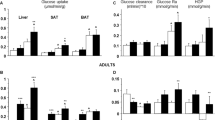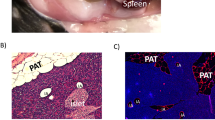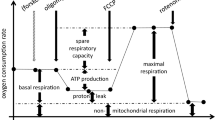Abstract
OBJECTIVE:
To determine the impact of obesity on adipocyte cell size and long-chain fatty acid (LCFA) uptake kinetics in human subjects undergoing laparoscopic abdominal surgery.
SUBJECTS:
A total of 10 obese patients (BMI 49.8±11.9 (s.d.) kg/m2) undergoing laparoscopic bariatric surgery, and 10 nonobese subjects (BMI 24.2±2.3 kg/m2) undergoing other clinically indicated laparoscopic abdominal surgical procedures.
MEASUREMENTS:
Cell size distribution and [3H]oleic acid uptake kinetics were studied in adipocytes isolated from omental fat biopsies obtained during surgery. Adipocyte surface area (SA) was calculated from the measured cell diameters. Plasma leptin and insulin concentrations were measured by RIA in fasting blood samples obtained on the morning of surgery.
RESULTS:
The mean SA of obese adipocytes (41 508±5381 μ2/cell) was increased 2.4-fold compared to that of nonobese adipocytes (16 928±6529 μ2/cell; P<0.01). LCFA uptake in each group was the sum of saturable and nonsaturable components. Both the Vmax of the saturable component (21.3±6.3 vs 5.1±1.9 pmol/s/50 000 cells) and the rate constant k of the nonsaturable component (0.015±0.002 vs 0.0066±0.0023 ml/s/50 000 cells) were increased (P<0.001) in obese adipocytes compared with nonobese controls. When expressed relative to cell size, Vmax/μ2 SA was greater in obese than nonobese adipocytes (P<0.05), whereas k/μ2 SA did not differ between the groups.
CONCLUSION:
The data support the concepts that (1) adipocyte LCFA uptake consists of distinct facilitated (saturable) and diffusive processes; (2) increased saturable LCFA uptake in obese adipocytes is not simply a consequence of increased cell size, but rather reflects upregulation of a facilitated transport process; and (3) the permeability of adipocyte plasma membranes to LCFA is not appreciably altered by obesity, and increased nonsaturable uptake in obese adipocytes principally reflects an increase in cell SA. Regulation of saturable LCFA uptake by adipocytes may be an important control point for body adiposity.
This is a preview of subscription content, access via your institution
Access options
Subscribe to this journal
Receive 12 print issues and online access
$259.00 per year
only $21.58 per issue
Buy this article
- Purchase on Springer Link
- Instant access to full article PDF
Prices may be subject to local taxes which are calculated during checkout





Similar content being viewed by others
References
Berk PD, Stump DD . Mechanisms of cellular uptake of long chain free fatty acids. Mol Cell Biochem 1999; 192: 17–31.
Stump DD, Fan X, Berk PD . Oleic acid uptake and binding by rat adipocytes define dual pathways for cellular fatty acid uptake. J Lipid Res 2001; 42: 509–520.
Berk PD, Zhou SL, Kiang CL, Stump D, Bradbury M, Isola LM . Uptake of long chain free fatty acids is selectively up-regulated in adipocytes of Zucker rats with genetic obesity and non-insulin-dependent diabetes mellitus. J Biol Chem 1997; 272: 8830–8835.
Berk PD, Zhou S, Kiang C, Stump DD, Fan X, Bradbury MW . Selective up-regulation of fatty acid uptake by adipocytes characterizes both genetic and diet-induced obesity in rodents. J Biol Chem 1999; 274: 28626–28631.
Fan X, Bradbury MW, Berk PD . Leptin and insulin modulate nutrient partitioning and weight loss in ob/ob mice through regulation of long-chain fatty acid uptake by adipocytes. J Nutr 2003; 133: 2707–2715.
Bradbury MW, Berk PD . Cellular uptake of long chain free fatty acids: the structure and function of plasma membrane fatty acid binding protein. Adv Mol Cell Biol 2004; 33: 47–81.
Abumrad NA, Perkins RC, Park JH, Park CR . Mechanism of long chain fatty acid permeation in the isolated adipocyte. J Biol Chem 1981; 256: 9183–9191.
Abumrad NA, Park JH, Park CR . Permeation of long-chain fatty acid into adipocytes. Kinetics, specificity, and evidence for involvement of a membrane protein. J Biol Chem 1984; 259: 8945–8953.
Schwieterman W, Sorrentino D, Potter BJ, Rand J, Kiang CL, Stump D, Berk PD . Uptake of oleate by isolated rat adipocytes is mediated by a 40-kDa plasma membrane fatty acid binding protein closely related to that in liver and gut. Proc Natl Acad Sci USA 1988; 85: 359–363.
Di Girolamo M, Mendlinger S, Fertig JW . A simple method to determine fat cell size and number in four mammalian species. Am J Physiol 1971; 221: 850–858.
Sorrentino D, Robinson RB, Kiang CL, Berk PD . At physiologic albumin/oleate concentrations oleate uptake by isolated hepatocytes, cardiac myocytes, and adipocytes is a saturable function of the unbound oleate concentration. Uptake kinetics are consistent with the conventional theory. J Clin Invest 1989; 84: 1325–1333.
Sorrentino D, Berk PD . Free fatty acids, albumin and the sinusoidal plasma membrane: concepts, trends and controversies. In: Tavoloni N, Berk PD (eds). Hepatic transport and bile secretion. Raven Press: New York; 1993. pp 197–210.
Stremmel W, Berk PD . Hepatocellular influx of [14C]oleate reflects membrane transport rather than intracellular metabolism or binding. Proc Natl Acad Sci USA 1986; 83: 3086–3090.
Wosilait WD, Nagy P . A method of computing drug distribution in plasma using stepwise association constants: clofibrate acid as an illustrative example. Comput Programs Biomed 1976; 6: 142–148.
Spector AA, Fletcher JE, Ashbrook JD . Analysis of long-chain free fatty acid binding to bovine serum albumin by determination of stepwise equilibrium constants. Biochemistry 1971; 10: 3229–3232.
Bojesen IN, Bojesen E . Binding of arachidonate and oleate to bovine serum albumin. J Lipid Res 1994; 35: 770–778.
Richieri GV, Anel A, Kleinfeld AM . Interactions of long-chain fatty acids and albumin: determination of free fatty acid levels using the fluorescent probe ADIFAB. Biochemistry 1993; 32: 7574–7580.
Rose H, Conventz M, Fischer Y, Jungling E, Hennecke T, Kammermeier H . Long-chain fatty acid-binding to albumin: re-evaluation with directly measured concentrations. Biochim Biophys Acta 1994; 1215: 321–326.
Berman M, Weiss MF . Users' manual for SAAM. US Government Printing Office: Washington DC; 1967.
##SAAM II user guide. SAAM Institute: Seattle, WA; 1998.
Snedecor GW, Cochran WG . Statistical methods, 6th edn. Iowa State University Press: Ames, Iowa; 1967.
Zinder O, Shapiro B . Effect of cell size on epinephrine- and ACTH-induced fatty acid release from isolated fat cells. J Lipid Res 1971; 12: 91–95.
Stump DD, Nunes RM, Sorrentino D, Isola LM, Berk PD . Characteristics of oleate binding to liver plasma membranes and its uptake by isolated hepatocytes. J Hepatol 1992; 16: 304–315.
The Surgeon General's call to action to prevent and decrease overweight and obesity—2001. U.S. Department of Health and Human Services, Public Health Service Office of the Surgeon General. Government Printing Office: Washington DC; 2001.
Yanovski SZ, Yanovski JA . Obesity. N Engl J Med 2002; 346: 591–602.
Leibel RL, Chung WK, Chua Jr SC . The molecular genetics of rodent single gene obesities. J Biol Chem 1997; 272: 31937–31940.
Sorrentino D, Stump D, Potter BJ, Robinson RB, White R, Kiang CL, Berk PD . Oleate uptake by cardiac myocytes is carrier mediated and involves a 40-kDa plasma membrane fatty acid binding protein similar to that in liver, adipose tissue, and gut. J Clin Invest 1988; 82: 928–935.
Stremmel W, Strohmeyer G, Berk PD . Hepatocellular uptake of oleate is energy dependent, sodium linked, and inhibited by an antibody to a hepatocyte plasma membrane fatty acid binding protein. Proc Natl Acad Sci USA 1986; 83: 3584–3588.
Groop LC, Saloranta C, Shank M, Bonadonna RC, Ferrannini E, DeFronzo RA . The role of free fatty acid metabolism in the pathogenesis of insulin resistance in obesity and noninsulin-dependent diabetes mellitus. J Clin Endocrinol Metab 1991; 72: 96–107.
Zakim D . Metabolism of glucose and fatty acids by the liver. In: Zakim D, Boyer TD (eds). Hepatology. Saunders: Philadelphia; 2002. pp 65–96.
Bjorntorp P . Fatty acids, hyperinsulinemia, and insulin resistance: which comes first? Curr Opin Lipidol 1994; 5: 166–174.
Kraegen EW, Cooney GJ, Ye JM, Thompson AL, Furler SM . The role of lipids in the pathogenesis of muscle insulin resistance and beta cell failure in type II diabetes and obesity. Exp Clin Endocrinol Diabetes 2001; 109 (Suppl 2): S189–S201.
McGarry JD . What if Minkowski had been ageusic? An alternative angle on diabetes. Science 1992; 258: 766–770.
McGarry JD . Disordered metabolism in diabetes: have we underemphasized the fat component? J Cell Biochem 1994; 55 (Suppl): 29–38.
Zhang Y, Proenca R, Maffei M, Barone M, Leopold L, Friedman JM . Positional cloning of the mouse obese gene and its human homologue. Nature 1994; 372: 425–432.
Friedman JM, Halaas JL . Leptin and the regulation of body weight in mammals. Nature 1998; 395: 763–770.
Zhou SL, Stump D, Sorrentino D, Potter BJ, Berk PD . Adipocyte differentiation of 3T3-L1 cells involves augmented expression of a 43-kDa plasma membrane fatty acid-binding protein. J Biol Chem 1992; 267: 14456–14461.
Zhou SL, Stump D, Kiang CL, Isola LM, Berk PD . Mitochondrial aspartate aminotransferase expressed on the surface of 3T3-L1 adipocytes mediates saturable fatty acid uptake. Proc Soc Exp Biol Med 1995; 208: 263–270.
Berk PD, Wada H, Horio Y, Potter BJ, Sorrentino D, Zhou SL, Isola LM, Stump D, Kiang CL, Thung S . Plasma membrane fatty acid-binding protein and mitochondrial glutamic-oxaloacetic transaminase of rat liver are related. Proc Natl Acad Sci USA 1990; 87: 3484–3488.
Bradbury MW, Berk PD . Mitochondrial aspartate aminotransferase: direction of a single protein with two distinct functions to two subcellular sites does not require alternative splicing of the mRNA. Biochem J 2000; 345 (Part 3): 423–427.
Stump DD, Zhou SL, Berk PD . Comparison of plasma membrane FABP and mitochondrial isoform of aspartate aminotransferase from rat liver. Am J Physiol 1993; 265 (Part 1): G894–G902.
Isola LM, Zhou SL, Kiang CL, Stump DD, Bradbury MW, Berk PD . 3T3 fibroblasts transfected with a cDNA for mitochondrial aspartate aminotransferase express plasma membrane fatty acid-binding protein and saturable fatty acid uptake. Proc Natl Acad Sci USA 1995; 92: 9866–9870.
Zhou SL, Stump D, Isola L, Berk PD . Constitutive expression of a saturable transport system for non-esterified fatty acids in Xenopus laevis oocytes. Biochem J 1994; 297 (Part 2): 315–319.
Bradbury MW, Berk PD . Lipid metabolism in hepatic steatosis. Clin Liver Dis 2004; 8: 639–671.
Acknowledgements
This work was supported by Grants DK-26438, DK-52401, and DK-66667 from the National Institutes of Health (NIDDK) and by the Mount Sinai Liver Disease Research Fund. We appreciate the advice of Dr Carol Bodian on biostatistical issues.
Author information
Authors and Affiliations
Corresponding author
Rights and permissions
About this article
Cite this article
Petrescu, O., Fan, X., Gentileschi, P. et al. Long-chain fatty acid uptake is upregulated in omental adipocytes from patients undergoing bariatric surgery for obesity. Int J Obes 29, 196–203 (2005). https://doi.org/10.1038/sj.ijo.0802868
Received:
Revised:
Accepted:
Published:
Issue Date:
DOI: https://doi.org/10.1038/sj.ijo.0802868
Keywords
This article is cited by
-
Safety and Efficacy of Laparoscopic Vertical Clip Gastroplasty: Early Results of an Italian Multicenter Study
Obesity Surgery (2023)
-
Adipocyte Accumulation of Long-Chain Fatty Acids in Obesity is Multifactorial, Resulting from Increased Fatty Acid Uptake and Decreased Activity of Genes Involved in Fat Utilization
Obesity Surgery (2010)
-
A Prospective Randomized Study Comparing Patients with Morbid Obesity Submitted to Laparotomic Gastric Bypass with or without Omentectomy
Obesity Surgery (2009)
-
Differences in adipocyte long chain fatty acid uptake in Osborne–Mendel and S5B/Pl rats in response to high-fat diets
International Journal of Obesity (2008)



